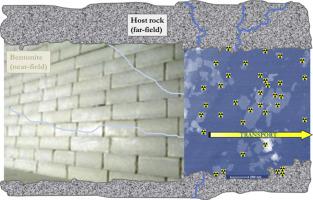当前位置:
X-MOL 学术
›
Appl. Clay. Sci.
›
论文详情
Our official English website, www.x-mol.net, welcomes your
feedback! (Note: you will need to create a separate account there.)
Erosion dynamics of compacted raw or homoionic MX80 bentonite in a low ionic strength synthetic water under quasi-stagnant flow conditions
Applied Clay Science ( IF 5.3 ) Pub Date : 2020-11-01 , DOI: 10.1016/j.clay.2020.105797 Muriel Bouby , Stephanie Kraft , Stefanie Kuschel , Frank Geyer , Sylvia Moisei-Rabung , Thorsten Schäfer , Horst Geckeis
Applied Clay Science ( IF 5.3 ) Pub Date : 2020-11-01 , DOI: 10.1016/j.clay.2020.105797 Muriel Bouby , Stephanie Kraft , Stefanie Kuschel , Frank Geyer , Sylvia Moisei-Rabung , Thorsten Schäfer , Horst Geckeis

|
Abstract Bentonite is planned to be used as a backfill material in deep geological repositories (DGR) notably for those to be established in crystalline rock. Potential erosion processes have to be clearly understood in order to properly assess its long-term barrier function. A likely scenario over the lifetime of a DGR in certain geographical locations is the intrusion of low mineralized glacial melt water through low transmissivity bedrock fractures that could interact with bentonite and favor release of clay colloids. The objective of this work was to determine the dynamic of erosion under a glaciation scenario for Na-exchanged, Na-Ca-exchanged, Ca-exchanged and raw bentonite. The different bentonite types cover different potential materials used for backfill and different stages of cation loading via cation exchange processes upon contact with groundwater of different composition. To this end, erosion experiments were carried out with highly compacted bentonite confined by a porous filter (20 μm) under dynamic conditions simulating the presence of a hydraulically active fracture filled with fault gauge and fracture filling minerals. The The erosion (clay colloid detachment) via a low mineralized groundwater flow was quantified by determining an average eluted mass loss rate (AMLR). AMLR values integrated over 1466 days (4 years) erosion time for the raw MX80 bentonite, the Na-MX80 and the Na-Ca-MX80 are at 0.019 ± 0.003 kg/y/m2, 0.245 ± 0.007 kg/y/m2 and 0.10 ± 0.02 kg/y/m2, respectively. Only by the sensitive ICP-MS analysis of clay-bound Th and U a tiny detachment of particles from Ca-MX80 could be identified, which shows the highest resistivity against erosion (0.004 ± 0.002 kg/y/m2). The experiments pointed to the swelling pressure as main driving force for colloid generation. A possible inhibiting effect of accessory minerals on erosion can also be deduced from this study. Assuming erosion via a groundwater flow from a single fracture intersecting a deposition hole filled with raw MX80 bentonite at an angle of 90o and with a fracture aperture of up to 200 μm, the present estimations indicated that under the given scenario the mass loss limit of 1200 kg bentonite will not be reached during the first 106 years.
中文翻译:

准滞流条件下低离子强度合成水中压实的原或均离子 MX80 膨润土的侵蚀动力学
摘要 膨润土计划用作深层地质储存库 (DGR) 的回填材料,特别是用于在结晶岩中建立的那些。必须清楚地了解潜在的侵蚀过程,才能正确评估其长期屏障功能。在某些地理位置,在 DGR 的整个生命周期中可能出现的情况是低矿化冰川融水通过低透射率基岩裂缝侵入,这些裂缝可能与膨润土相互作用并有利于粘土胶体的释放。这项工作的目的是确定冰川作用下 Na 交换、Na-Ca 交换、Ca 交换和原始膨润土的侵蚀动态。不同的膨润土类型涵盖了用于回填的不同潜在材料,以及在与不同成分的地下水接触时通过阳离子交换过程加载阳离子的不同阶段。为此,在动态条件下用多孔过滤器 (20 μm) 限制的高度压实的膨润土进行了侵蚀实验,模拟了充满断层仪和裂缝填充矿物的水力活动裂缝的存在。通过确定平均洗脱质量损失率 (AMLR) 量化通过低矿化地下水流产生的侵蚀(粘土胶体脱离)。原始 MX80 膨润土、Na-MX80 和 Na-Ca-MX80 在 1466 天(4 年)侵蚀时间内积分的 AMLR 值为 0.019 ± 0.003 kg/y/m2、0.245 ± 0.007 kg/y/m2 和 0.10分别为 ± 0.02 kg/y/m2。只有通过对粘土结合的 Th 和 U 进行灵敏的 ICP-MS 分析,才能从 Ca-MX80 中识别出微小的颗粒脱离,这显示出最高的抗侵蚀性 (0.004 ± 0.002 kg/y/m2)。实验指出溶胀压力是胶体生成的主要驱动力。从这项研究中还可以推断出副矿物对侵蚀的可能抑制作用。假设来自单个裂缝的地下水流以 90 度角与填充原始 MX80 膨润土的沉积孔相交,裂缝孔径高达 200 微米,目前的估计表明,在给定的情况下,质量损失限制为 1200在最初的 106 年内不会达到千克膨润土。这显示出最高的抗侵蚀电阻率 (0.004 ± 0.002 kg/y/m2)。实验指出溶胀压力是胶体生成的主要驱动力。从这项研究中还可以推断出副矿物对侵蚀的可能抑制作用。假设来自单个裂缝的地下水流以 90 度角与填充原始 MX80 膨润土的沉积孔相交,裂缝孔径高达 200 微米,目前的估计表明,在给定的情况下,质量损失限制为 1200在最初的 106 年内不会达到千克膨润土。这显示出最高的抗侵蚀电阻率 (0.004 ± 0.002 kg/y/m2)。实验指出溶胀压力是胶体生成的主要驱动力。从这项研究中还可以推断出副矿物对侵蚀的可能抑制作用。假设来自单个裂缝的地下水流以 90 度角与填充原始 MX80 膨润土的沉积孔相交,裂缝孔径高达 200 微米,目前的估计表明,在给定的情况下,质量损失限制为 1200在最初的 106 年内不会达到千克膨润土。
更新日期:2020-11-01
中文翻译:

准滞流条件下低离子强度合成水中压实的原或均离子 MX80 膨润土的侵蚀动力学
摘要 膨润土计划用作深层地质储存库 (DGR) 的回填材料,特别是用于在结晶岩中建立的那些。必须清楚地了解潜在的侵蚀过程,才能正确评估其长期屏障功能。在某些地理位置,在 DGR 的整个生命周期中可能出现的情况是低矿化冰川融水通过低透射率基岩裂缝侵入,这些裂缝可能与膨润土相互作用并有利于粘土胶体的释放。这项工作的目的是确定冰川作用下 Na 交换、Na-Ca 交换、Ca 交换和原始膨润土的侵蚀动态。不同的膨润土类型涵盖了用于回填的不同潜在材料,以及在与不同成分的地下水接触时通过阳离子交换过程加载阳离子的不同阶段。为此,在动态条件下用多孔过滤器 (20 μm) 限制的高度压实的膨润土进行了侵蚀实验,模拟了充满断层仪和裂缝填充矿物的水力活动裂缝的存在。通过确定平均洗脱质量损失率 (AMLR) 量化通过低矿化地下水流产生的侵蚀(粘土胶体脱离)。原始 MX80 膨润土、Na-MX80 和 Na-Ca-MX80 在 1466 天(4 年)侵蚀时间内积分的 AMLR 值为 0.019 ± 0.003 kg/y/m2、0.245 ± 0.007 kg/y/m2 和 0.10分别为 ± 0.02 kg/y/m2。只有通过对粘土结合的 Th 和 U 进行灵敏的 ICP-MS 分析,才能从 Ca-MX80 中识别出微小的颗粒脱离,这显示出最高的抗侵蚀性 (0.004 ± 0.002 kg/y/m2)。实验指出溶胀压力是胶体生成的主要驱动力。从这项研究中还可以推断出副矿物对侵蚀的可能抑制作用。假设来自单个裂缝的地下水流以 90 度角与填充原始 MX80 膨润土的沉积孔相交,裂缝孔径高达 200 微米,目前的估计表明,在给定的情况下,质量损失限制为 1200在最初的 106 年内不会达到千克膨润土。这显示出最高的抗侵蚀电阻率 (0.004 ± 0.002 kg/y/m2)。实验指出溶胀压力是胶体生成的主要驱动力。从这项研究中还可以推断出副矿物对侵蚀的可能抑制作用。假设来自单个裂缝的地下水流以 90 度角与填充原始 MX80 膨润土的沉积孔相交,裂缝孔径高达 200 微米,目前的估计表明,在给定的情况下,质量损失限制为 1200在最初的 106 年内不会达到千克膨润土。这显示出最高的抗侵蚀电阻率 (0.004 ± 0.002 kg/y/m2)。实验指出溶胀压力是胶体生成的主要驱动力。从这项研究中还可以推断出副矿物对侵蚀的可能抑制作用。假设来自单个裂缝的地下水流以 90 度角与填充原始 MX80 膨润土的沉积孔相交,裂缝孔径高达 200 微米,目前的估计表明,在给定的情况下,质量损失限制为 1200在最初的 106 年内不会达到千克膨润土。











































 京公网安备 11010802027423号
京公网安备 11010802027423号